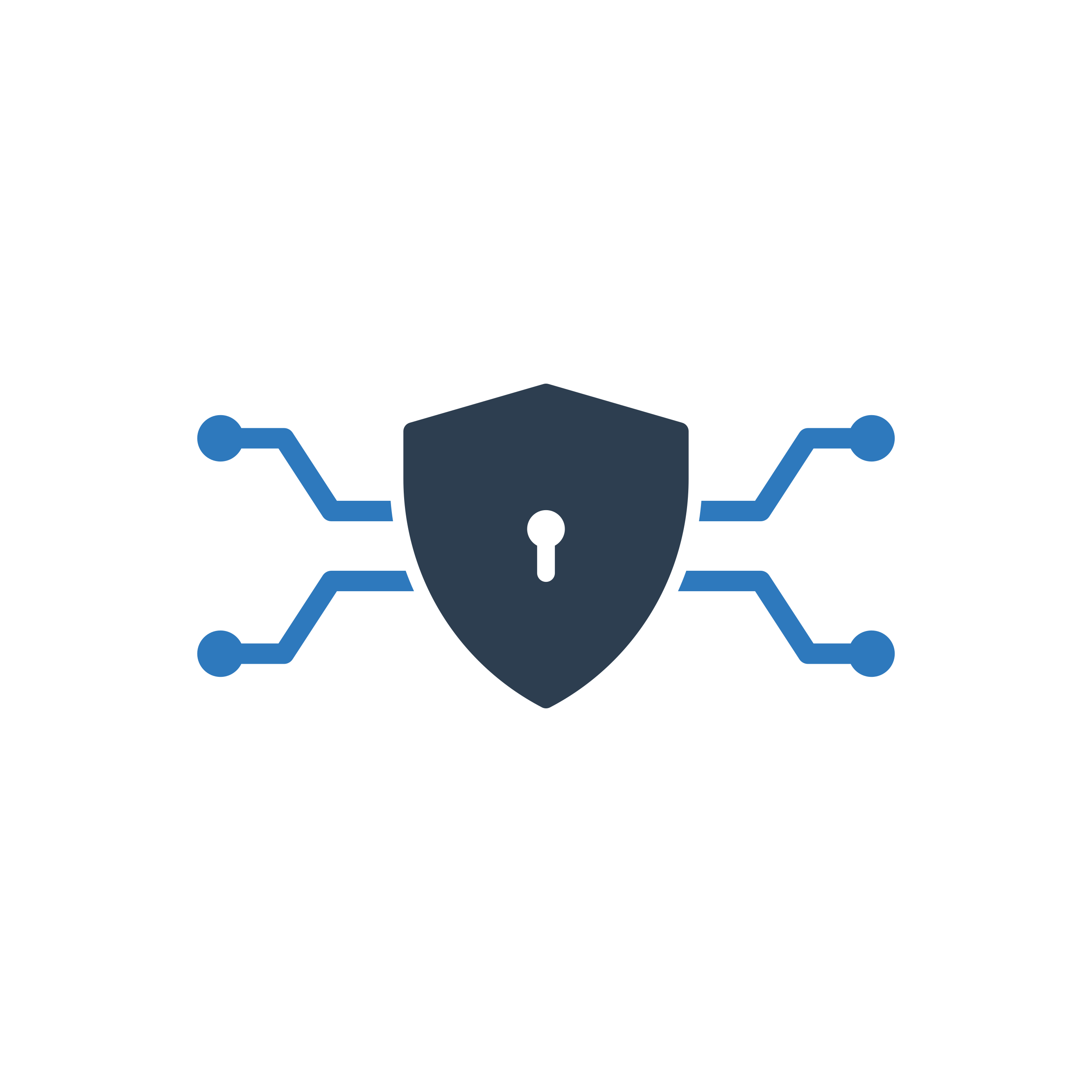TABLE OF CONTENTS
Q3 of 2024 marked a record increase in cyber attacks, up 75% compared to the third quarter of 2023. With cybersecurity risks escalating, especially for companies handling sensitive government data, compliance has become critical in defense, aerospace, and government contracting sectors.
This article overviews the three most commonly used NIST compliance guidelines: CSF, NIST SP 800-53, and NIST SP 800-171. We’ll explore what NIST compliance entails, its benefits, and how companies can achieve it.
What is NIST compliance?
The National Institute of Standards and Technology (NIST) is a non-regulatory U.S. government agency that develops guidelines for measurements, standards, and best practices in science and technology. NIST compliance promotes innovation and industrial competitiveness in the U.S. and establishes cybersecurity and information technology standards guidelines.
The most commonly used NIST frameworks are as follows:
- Cybersecurity Framework (CSF),
- Special Publication 800-53 (SP 800-53),
- Special Publication 800-171 (SP 800-171).
These publications are designed for use by government organizations and companies that use federal systems to ensure proper security controls around sensitive data.
Who needs NIST compliance?
If your business handles sensitive government data or operates federal information systems, NIST compliance is required to ensure data security. Failure to do so can result in losing current or future contracts. The specific NIST guidelines required will depend on your business’s level of access to government data.
For example, all federal agencies and some private-sector aerospace and defense companies must comply with NIST SP 800-53. Companies that handle Controlled Unclassified Information (CUI) must comply with NIST SP 800-171. NIST compliance is not mandatory for private companies that do not handle government data. However, as it is widely regarded as the gold standard for cybersecurity, adherence is still highly recommended.
NIST Compliance Benefits
Enhanced Cybersecurity
NIST compliance ensures data is handled securely, helping to prevent intellectual property theft, data leaks, and cyberattacks. By implementing security controls such as encryption, identity management, and continuous monitoring, organizations can defend against threats and minimize damage in case of a breach. This is particularly important for defense and aerospace companies that handle sensitive government data, where national security is at stake.
Competitive Advantage
NIST compliance is often required to secure federal contracts, notably in the defense and aerospace industries. Companies bidding on Department of Defense (DoD) contracts must comply with NIST SP 800-171. Demonstrating compliance ensures eligibility and boosts a company’s reputation, giving it a competitive edge over companies that may not meet these strict cybersecurity standards.
Alignment with Other Standards
NIST standards, particularly 800-171 and 800-53, significantly overlap with other cybersecurity and compliance frameworks, such as the Cybersecurity Maturity Model Certification (CMMC), System and Organization Controls 2 (SOC 2), and International Organization for Standardization/International Electrotechnical Commission (ISO/IEC 27001).
If a company is NIST compliant, it is usually easier to achieve compliance with these other frameworks. This reduces the burden of getting multiple certifications, particularly for companies in highly regulated industries like defense and aerospace.
NIST Cybersecurity Framework
The Cybersecurity Framework (CSF) is a high-level NIST guide that helps organizations manage and reduce cybersecurity risks. Originally developed for critical infrastructure organizations, it is now widely used across industries, including the private sector.
The framework is designed to be flexible and suitable for organizations of all sizes and maturity levels. For small and medium-sized businesses with no cybersecurity plans, NIST offers a CSF Quick Start Guide, a simplified version of the CSF.
The CSF takes a risk-focused approach centered around five core functions:
- Identify: Recognize key systems, assets, data, and resources to understand what needs to be protected.
- Protect: Safeguard identified assets using controls such as access control, data encryption, user authentication, and protective technology.
- Detect: Implement monitoring and detection processes to identify cybersecurity events, such as unusual login patterns or traffic spikes.
- Respond: Create structured response plans to mitigate the impact of detected events, including incident response procedures.
- Recover: Establish recovery plans to restore systems after an incident, maintain communication with stakeholders, and improve cybersecurity measures based on lessons learned.
The CSF is a broader overview of cybersecurity recommendations than SP 800-53 and 800-171, which we’ll define next.
NIST SP 800-53
NIST Special Publication 800-53 (Security and Privacy Controls for Federal Information Systems and Organizations) outlines comprehensive security controls that are mandatory for all federal agencies under the Federal Information Security Modernization Act (FISMA). These controls protect federal information systems and ensure sensitive government data’s confidentiality, integrity, and availability.
Contractors and subcontractors managing federal systems, particularly in sectors like defense and aerospace, must also comply with SP 800-53. This includes companies responsible for managing radar and missile systems for the Department of Defense (DoD) or those with access to military flight control systems.
NIST SP 800-53 contains a rigorous set of 20 families of security and privacy controls, organized based on the system’s impact level – low, moderate, or high. High-impact environments like national security systems have the most stringent controls.
NIST SP 800-171
NIST SP 800-171 (Protecting Controlled Unclassified Information in Nonfederal Systems and Organizations) outlines cybersecurity requirements for protecting Controlled Unclassified Information (CUI) when stored, processed, or transmitted in nonfederal information systems. This ensures that sensitive but unclassified government data is protected.
Contractors, subcontractors, and nonfederal organizations working with the federal government must comply with SP 800-171. This includes defense contractors who handle CUI but not classified information, as well as aerospace manufacturers and research institutions working on federally funded projects involving CUI.
Compared to SP 800-53, SP 800-171 is more streamlined and designed specifically for nonfederal systems, so it’s easier for contractors to implement. It contains 14 families of security and privacy controls.
How do I get NIST Compliance?
The first step in becoming NIST compliant is determining which NIST standard applies to your organization—the Cybersecurity Framework (CSF), NIST SP 800-171, or NIST SP 800-53. Once you have identified the appropriate standard, you must follow a structured approach to meet the required controls and guidelines.
This involves conducting a thorough gap analysis, implementing necessary security measures, and continuously monitoring your cybersecurity posture. Documenting your compliance efforts is also critical, as this will be essential for audits and demonstrating your adherence to NIST standards when working with federal agencies.
Since NIST is a standards body, not a regulatory agency, it does not issue compliance certifications. Instead, compliance is demonstrated to the federal agency or entity that requires it. Contractors handling controlled unclassified information must comply with SP 800-171 and typically either submit a self-assessment score to the Supplier Performance Risk System (SPRS) or undergo a third-party audit under CMMC.
Contractors handling classified information must comply with SP 800-53, and generally undergo third-party audits, in addition to being subject to oversight by the federal agency they work with to verify ongoing compliance.
NIST Compliance Checklist
Assess Risks
Conduct a risk assessment of your systems to compare current cybersecurity practices against NIST requirements. Tools like NIST’s Cybersecurity Assessment Tool or third-party audits may be helpful to identify gaps.
Develop and Implement Controls
Create a Plan of Action and Milestones (POA&M). This plan should identify necessary tasks, allocate resources, and set deadlines for reaching compliance.
Incident Response and Recovery Plans
Develop and test incident response and recovery plans to safeguard critical systems and effectively respond to security breaches.
Training and Awareness
Conduct a risk assessment of your systems to compare current cybersecurity practices against NIST requirements. Tools like NIST’s Cybersecurity Assessment Tool or third-party audits may be helpful to identify gaps.
Monitor and Audit
Continuously monitor systems and conduct regular security assessments to stay compliant. Update security controls as new threats and vulnerabilities emerge
Contractors handling classified information must comply with SP 800-53, and generally undergo third-party audits, in addition to being subject to oversight by the federal agency they work with to verify ongoing compliance.
The Takeaway on NIST Compliance
NIST compliance protects organizations from cybersecurity threats and provides a competitive edge, particularly in sectors like defense and aerospace. Achieving NIST compliance ensures that your business can meet the highest security standards, which is increasingly important in today’s landscape of ever-evolving cyber risks.
By adhering to NIST standards like SP 800-53 and SP 800-171, companies safeguard sensitive information and demonstrate their commitment to rigorous cybersecurity practices. This commitment is valuable when bidding for contracts with government agencies, especially in the aerospace and defense industries.
Investing in NIST compliance can position businesses as reliable partners capable of meeting stringent security requirements while reducing the risk of cyber threats. When you do, make sure to have your NIST compliance checklist at hand and ready to go.


